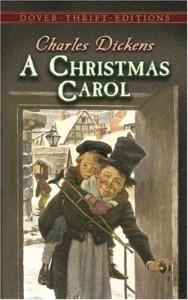 Last night we saw a live production of Charles Dickens’ A Christmas Carol at the San Jose Repertory Theater and once again I’m reminded of why I love this story. Standing the test of time this tale has been a consistent part of the literary, theatrical, and social scene since it was published in 1843. 6,000 copies were sold in its first week of printing and within the year it inspired nine London stage productions. Every year since, countless A Christmas Carol film, theater, opera, radio and television productions have followed. Even animated celebrities like Mickey Mouse, the Muppets, Bugs Bunny, Mr. Magoo, and Barbie have starred in their own versions. It’s really quite phenomenal.
Last night we saw a live production of Charles Dickens’ A Christmas Carol at the San Jose Repertory Theater and once again I’m reminded of why I love this story. Standing the test of time this tale has been a consistent part of the literary, theatrical, and social scene since it was published in 1843. 6,000 copies were sold in its first week of printing and within the year it inspired nine London stage productions. Every year since, countless A Christmas Carol film, theater, opera, radio and television productions have followed. Even animated celebrities like Mickey Mouse, the Muppets, Bugs Bunny, Mr. Magoo, and Barbie have starred in their own versions. It’s really quite phenomenal.
What motivated Dickens to write A Christmas Carol? It would be wonderful to say he was inspired by the spirit of Christmas, but actually, he needed the money. So much so that he wrote the book in just six weeks, made sure it was ready in time for Christmas, published it himself so he could keep the greater share of the profits, and kept it short to be more readable. It was only 74 pages while most books of the time were at 500–1000 pages long. Dickens affectionately called it his “little Christmas book” and read excerpts from it at public readings until his death.
His timing couldn’t have been better. Christmas was making a meager comeback from being a religious holiday banned about 200 years earlier by the Puritans, but times were changing. The same year A Christmas Carol was published the first Christmas cards appeared and Prince Albert brought the first Christmas tree to England. Dickens was instrumental in those changes since his story portrayed Christmas as a joyous holiday, not just a solemn, austere holy day reflecting the asceticism of that era.
A Christmas Carol deals with two of Dickens’ favorite themes: social injustice and poverty. Ebenezer Scrooge represents those who thought their wealth and status gave them the right to sit in judgment of the poor, rather than help them dig their way out of poverty. Bob Cratchit, his loyal employee, represents the poor working man just trying to eke out a meager living for his family. One of the peripheral but pivotal characters is Cratchit’s young, disabled son, Tiny Tim. In spite of Tiny Tim’s dire circumstances, he remains cheerful.
After Scrooge encounters his ghosts/spirits (Christmas Past, Christmas Present, and Christmas Future), he’s delighted to find out he has time to change his selfish ways. He becomes a good man, a true friend, and compassionate employer. He gives money to charity workers, buys gifts for everyone, spends time with his estranged family, helps the Cratchits, becomes a second father to Tiny Tim, and “it was always said of him, that he knew how to keep Christmas well, if any man alive possessed the knowledge.”
Although variations of the plot have been done, redone, improvised, used, abused, misused, and overdone, it’s still one of my favorite Christmas stories. True, it does not emphasize the birth of Jesus, but it does have certain nuances that make us think. When Tiny Tim and his father go to church on Christmas day Tim makes a brief reference to Christ by saying we should remember the one who made lame beggars walk and blind men see.
All can relate to underlying themes throughout A Christmas Carol. Timeless themes like do unto others as you would have them do unto you, what goes around comes around, family is important, money does not bring happiness, love lasts all year long, redemption, forgiveness, and being thankful are just a few that still resonate. All worthy concepts to think about during a Christmas season.
And as far as I’m concerned, you can’t get a better ending than Tiny Tim saying, “God bless us, every one!”

